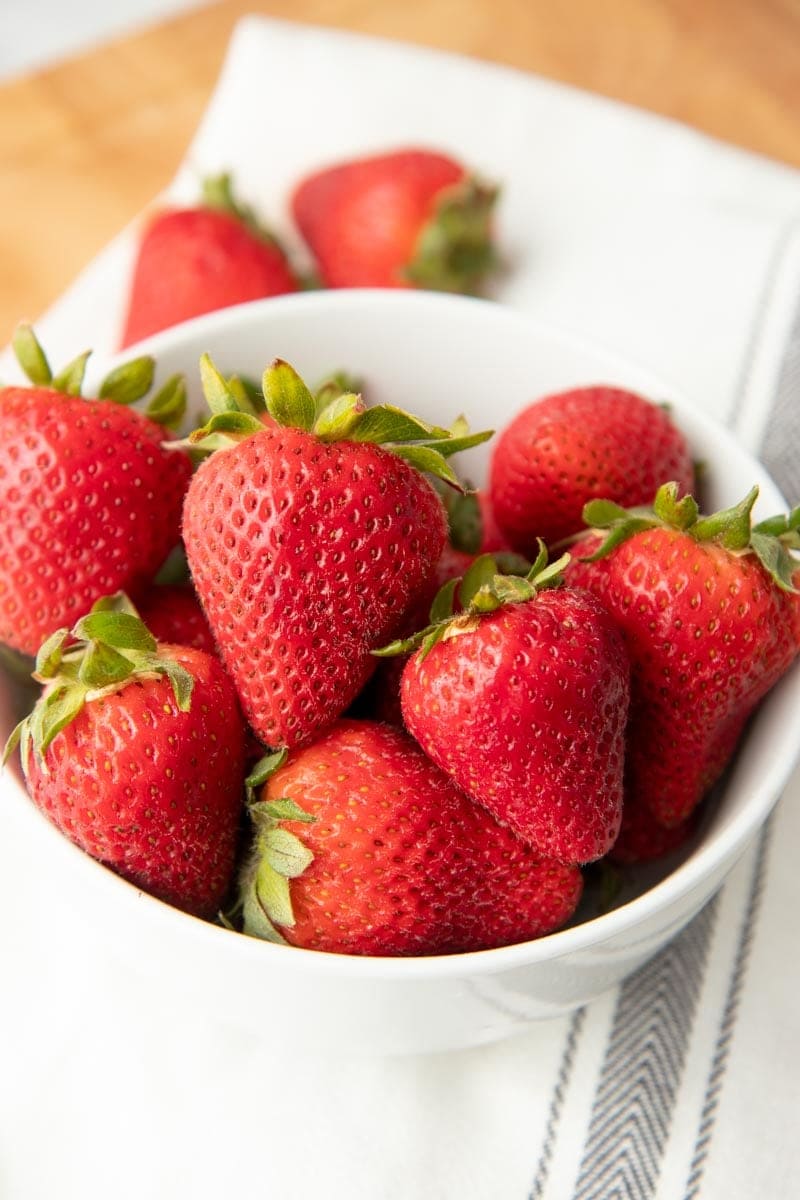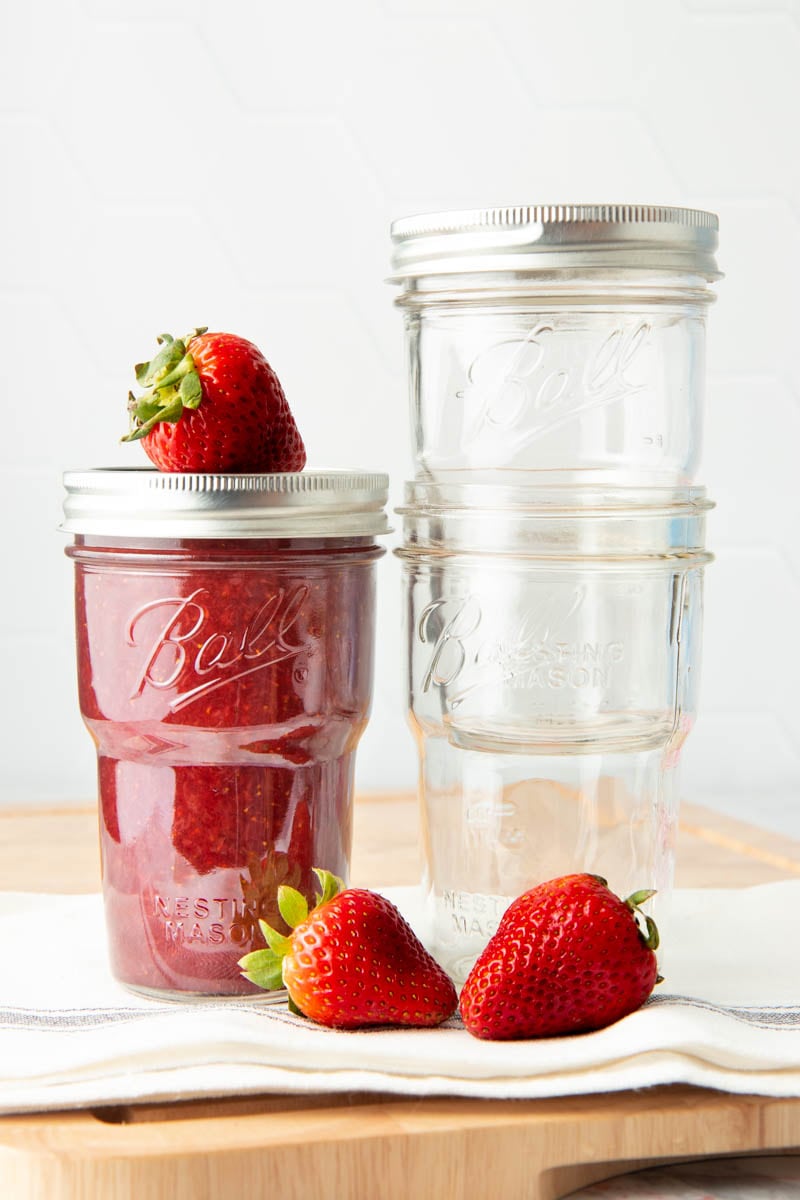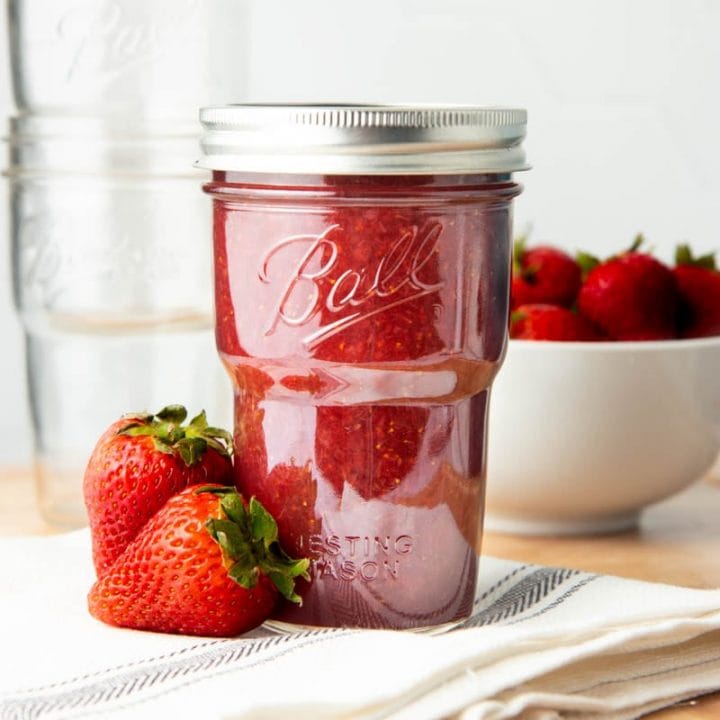When it comes to canning, there are few recipes that are more classic or more universally loved than Strawberry Jam. Homemade Strawberry Jam seems almost too simple—just fresh strawberries and real sugar—but magic happens as the jam bubbles away on the stove, and you are left with a thick, sweet, fruity spread that tastes like summertime and elevates your English muffins.
We’re sharing our traditional easy Strawberry Jam recipe today—that means strawberry jam without added pectin. We think this is the BEST strawberry jam because of its beautiful simplicity! While we love using pectin for jams, sometimes you can’t get your hands on it or maybe you are just in the mood to enjoy your jam in the purest of ways. No matter your motivation, we’re going to hold your hand all the way through the process, from fresh berry to beautiful, giftable jam jars! Let’s get canning.

How can I thicken strawberry jam without pectin?
Commercial pectin is a staple in many canners’ kitchens, but it’s completely possible to make jam without adding pectin. The key is to boil the jam to the proper gelling point on a kitchen thermometer (in this case, that’s 220°F)—just like you’d do if you were making candies, syrups, or caramel. While strawberries are low in natural pectin, it does exist! And when you get the jam up to the gelling point, the pectin is released and your jam will cool to a pleasant consistency.

It takes a bit of patience (and a good kitchen thermometer), but we promise you can make strawberry jam without pectin at home—no matter your skill level!
Wholefully Protip
Berries that are slightly unripe have more natural pectin than their ripe (and delicious) friends. To ensure gelling, toss a couple of berries with a bit of white or green on them into each batch (but no more than ¼ of the berries used should be underripe).
If you are interested in a strawberry jam recipe that contains pectin, try our Mixed Berry Jam, Strawberry-Rhubarb Jam, or Classic Strawberry Jam.
How many strawberries do you need to make this strawberry jam recipe?
This recipe calls for 2 quarts of mashed strawberries, which is equal to about 4 to 5 pounds of fresh berries. That will get you 8 Ball® Half-Pint or Jelly Jars or 4 Ball® Pint Jars.

How do you make strawberry jam without pectin?
You’ll be blown away at how simple the steps are to make your own jam at home. We have a printable version of the recipe below, but here is the gist of it:

- Wash and hull strawberries.
- Mash the strawberries one layer at a time using a potato masher.
- Measure out 2 quarts of crushed strawberries.
- Combine the crushed strawberries with 6 cups of granulated sugar in a large pot.
- Bring the mixture to a boil, stirring to dissolve the sugar.
- Simmer over medium-high heat until it reaches the gelling point (220°F), stirring regularly to prevent scorching. Skim off any foam if necessary.
Wholefully Protip
You can also use an immersion blender to crush your strawberries.
How do you can this strawberry jam recipe?
Because of the high acid content of strawberries, this jam recipe is safe for waterbath canning. You can follow our tutorial on waterbath canning or visit the Ball® Waterbath Canning Guide for more information on how to preserve this recipe safely.
Wholefully Protip
Not interested in canning? No worries. Allow the jars to cool, and then you can pop this homemade jam in the refrigerator and enjoy it within 3 weeks, or freeze and enjoy it within a year. If freezing, make sure to use a freezer-safe jar (a jar with straight or tapered sides and no shoulders) like Ball® Wide Mouth Pint Jars or Ball® Half-Pint Jars.
What are the best canning jars to use for strawberry jam?
Jam is relatively flexible on the size and type of jar you can use. In these photos, we are using Ball® Nesting Pint Jars—which are great because when not in use, they stack together and save tons of shelf space! This recipe also works with any other Ball® Pint Jar or Ball® Half-Pint or Jelly Jar.

Why doesn’t this recipe use lemon juice?
Lemon juice in canning recipes is typically used to acidify a recipe to make it safe for waterbath canning. Any food with a pH lower than 4.6 is safe for waterbath canning. Strawberries have a pH of between 3.0 to 3.5 depending on the cultivar, making them perfectly safe to waterbath can without acidification.
Wholefully Protip
Some folks add lemon juice because they enjoy the strawberry-lemon flavor! If that’s you, check out this Strawberry Lemon Marmalade recipe.
How do you know when jam is ready?
This jam is ready when it reaches 220°F.
You can also double-check your jam set by placing a small saucer or bowl in the fridge or freezer while your jam cooks. When you think the jam is getting close, remove it from heat, and spoon a small amount onto the cold saucer or bowl and pop it back in the freezer for a minute or two. Draw your finger through the jam puddle—a good jam set will not flood back into the space quickly. If your jam isn’t quite ready yet, just pop the pot back onto medium heat and extend the cooking time for a bit longer, then test again.

Can you over boil jam?
Yes! The longer jam boils, the thicker it gets, eventually turning into something similar to fruit leather after cooling—still delicious, but awfully hard to get out of the jar and spread on toast! That’s why we recommend having a good kitchen thermometer close by.
Can you make jam with frozen fruit?
Yes, this jam is a perfect opportunity to use up the strawberries kicking around in your freezer. Partially thaw the berries (there should still be ice crystals present), and then follow the recipe starting with the crushing step. We do not recommend using pre-sweetened frozen strawberries.

What is the ratio of sugar to fruit when making jam?
This recipe uses 2 quarts of mashed strawberries to 6 cups of granulated sugar.
How long does strawberry jam last?
Properly sealed preserves are best used within 18 months. However, as long as the jar still has a good seal, canned goods can be stored almost indefinitely. The quality of the food might decrease (you might lose flavor, color, or texture), but it will still be safe to eat.

What are some great ways to use strawberry jam?
Homemade jam isn’t just for PB&Js (although that’s a great use)—once you have a stash of your own jam, you’ll find all kinds of uses for it! Here are some of our faves:
- Slather it on top of pancakes instead of maple syrup.
- Mix it into your yogurt for a wonderful, fruity breakfast.
- Drizzle it on top of your favorite ice cream!
- Mix it into overnight oats to add sweetness and fruity flavor.

Strawberry Jam without Pectin
Strawberry jam is a delicious way to put this summer’s fresh berry bounty to good use. Here’s everything you need to know to make easy-to-prepare strawberry jam with a perfect set every time.
Recipe from the Ball Blue Book.
Ingredients
- 2 quarts strawberries (about 4-5 pounds)
- 6 cups sugar
Instructions
- Wash strawberries under cold running water; drain. Remove stems and caps from strawberries. Crush strawberries one layer at a time using a potato masher. Measure 2 quarts crushed strawberries.
- Combine crushed strawberries and sugar in a large saucepan. Bring mixture to a boil, stirring until sugar dissolves. Cook rapidly over medium-high heat to gelling point (220°F), stirring to prevent sticking. Remove from heat. Skim off foam if necessary.
- Ladle hot jam into a hot jar, leaving 1/4-inch headspace. Remove air bubbles. Clean jar rim. Center lid on jar and adjust band to fingertip-tight. Place jar on the rack elevated over simmering water (180°F) in boiling-water canner. Repeat until all jars are filled.
- Lower the rack into simmer water. Water must cover jars by 1 inch. Adjust heat to medium-high, cover canner, and bring water to a rolling boil. Process half-pint or pint jars 15 minutes. Turn off heat and remove cover. Let jars cool 5 minutes. Remove jars from canner; do not retighten bands if loose. Cool 12 hours. Check seals. Label and store jars.
Nutrition Information:
Yield: 128 Serving Size: 1 tablespoonAmount Per Serving: Calories: 40Total Fat: 0gSaturated Fat: 0gTrans Fat: 0gUnsaturated Fat: 0gCholesterol: 0mgSodium: 0mgCarbohydrates: 10gFiber: 0gSugar: 10gProtein: 0g
At Wholefully, we believe that good nutrition is about much more than just the numbers on the nutrition facts panel. Please use the above information as only a small part of what helps you decide what foods are nourishing for you.

